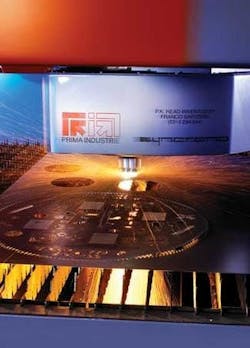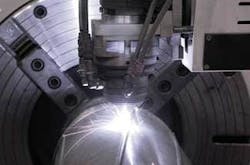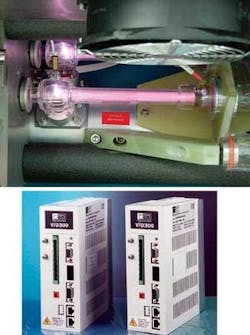European photonics: Should we be worried?
STUART WOODS
The European Union launched its Photonics21 technology platform late in 2005. The intent was to ensure Europe remains competitive in the global photonics community by providing a strong focus on photonics in the EU Seventh Framework Programme funding scheme. Last year in our annual European Report we reviewed the Photonics21 platform and its Strategic Research Agenda put forward by some of Europe’s leading companies (see www.laserfocusworld.com/16546529).
In this year’s European Report, contributing technology consultant, Stuart Woods, takes another look at Photonics21 and its potential impact—this time from the point of view of Europe’s photonics leaders. Now 18 months after its introduction, how do these leaders feel about Photonics21? To what extent can Photonics21 and the Seventh Framework be effective in bringing about changes in Europe that will ensure it continues to be a major player in the photonics marketplace? And can Europe maintain its competitiveness in photonics with growing concerns over lower-cost photonics manufacturing in Asia after the enabling technology is developed?
More than 200,000 jobs throughout Europe are directly dependent on photonics. With two million total jobs at stake, this represents about 16% of the working European population. As in other parts of the world, photonics in Europe directly underpins such critical markets as the automotive, medical, telecommunications, and information technology sectors. How do we protect these jobs? How do we grow this sector? With such a large number of jobs at stake, should we in Europe be worried?
To put these questions and the current situation in perspective, it is important to understand what the European Union (EU) has done over the last decade to stimulate and support the European research community. Since 1984, the EU has been organizing “framework programmes” that are designed to fund research ranging from biotechnology ethical and social issues to fundamental nanotechnology development. In 1997, the Amsterdam Treaty—which amended the Treaty on European Union—made it a legal and political requirement to realize pan-European research programs. The treaty, in fact, included an entire chapter on research and development to emphasize this importance.
In December 2005, the Photonics21 platform was launched in Brussels with the mission to unite the European photonics industry around a common platform for investment in photonics research and development and provide a strong focus on photonics in the upcoming European Union Seventh Framework Programme (FP7). In January 2007, the European Commission created a new unit headed by Thierry van der Pyl intended to enable photonics technology in 2007 and 2008.
“I believe that it was an important success of Photonics21, to convince the European Commission to create a dedicated unit for photonics,” says Bernd Schulte, vice president of Photonics21, president of the European Photonics Industry Consortium (EPIC; www.epic-assoc.com), and executive vice president and COO at Aixtron in Germany (www.aixtron.com). “It is an important step by the Commission to give the photonics community a direct access and a focus. You can be assured that P21 will not stop promoting photonics technologies to the EU.”
Steve Turley, chief commercial officer at Bookham in England (www.bookham.com), says his company sees Photonics21 as a good first step in highlighting the needs of the European photonics industry.
“We are encouraged by the positive reaction it has received from the European Commission,” he says. “However, it is important to realize that this is a first step in an ongoing journey and we need to ensure that the current investment goes into all stages of the development of the photonics industry to ensure that we have innovative future technologies to fuel growth for many decades into the future.”
Only the beginning
But Photonics21 is only a beginning. To be truly successful, it is critical that each EU country with stakeholdings in photonics sets up its own working groups to provide input on a reasonable time scale to the European Commission. Today, Photonics21 membership has grown to 700 members representing 37 countries. But the task of revolutionizing the way photonics is supported in Europe is, as Turley points out, “a first step.” With two-thirds of the European photonics workforce employed by small- and medium-size enterprises (SMEs), the European Commission can no longer continue to rely on the traditional framework programmes to keep Europe competitive in the increasingly global photonics marketplace.
The effectiveness and success of framework programmes in supporting SMEs has been a recurring theme within the European Union’s Research and Development Programmes. In 2005, the EU’s own five-year report reviewing its Research and Development Programmes recommended more industry participation, especially by SMEs, a streamlined and simplified administration, and more emphasis on radical innovation and risk-taking. In talking with many leaders of SMEs, it is clear they believe the EU has not adequately addressed these issues.
“Photonics21 as a European platform is, of course, a good thing for European photonics,” says Samuel Bucourt, CEO of Imagine Optic in France (www.imagine-optic.com) and president of AFOP, (the French Optics and Photonics Manufacturers Association; www.gifo.org). “But some difficulties remain. First, SMEs are not well represented and it is very difficult for these companies to integrate into a consortium. Second, German companies dominate Photonics21. The success of these German companies is linked to their national organizations and resources, which are not the same from one country to another.”
Ezio Basso, general manager of Prima Industrie in Italy (www.primaindustrie.com), concurs. “In general, Prima is not structured to follow and to be the main contractor in European programs,” he says. “We are working and will work on the framework programmes, but our involvement will be with another main contractor.”
While not classified as an SME, Prima Industrie is smaller than many of its competitors. “Medium-size companies such as Prima Industrie have problems participating in such programmes,” says Basso. “People consider that we have done particularly well with good results in the last year. But we are a medium-size company with all the problems of a medium-size company, but the job that we have to do is exactly the same as a big company” (see Fig. 1).
Basso agrees that individual European countries approach the issue of funding and support differently. The amount of funding put into research by the Italian government is very low when compared with Finland or Germany, for instance. However, the situation is improving. Starting last year, some smaller financial grants became available at the regional level.
“It is important to understand that Italy is quite different from the other European countries-in Germany the companies are generally bigger than in Italy, but in Italy the medium-size companies are the engines of the country,” Basso says. “Therefore, in some countries European photonics funding may need to be directed at the regional level in order to reach SMEs.”
In the United Kingdom, David Parker, president and CEO of SPI Lasers (www.spilasers.com), says it is clear that for the framework programmes to contribute to Europe’s future success, they must change radically.
“I think the issue that [SPI Lasers] has with the framework programmes is the bureaucratic overhead,” Parker says. “There is a tendency for the consortia to become too big, and while the cross-European collaboration element is a good thing, what tends to happen is you get what I call the ‘coloring-in of the map,’ where all these different partners feel that they have to check all sorts of boxes: do the programs have the right amount of big companies, small companies, universities, northern European, eastern European, southern Europeans and so on? People get involved in this debate instead of what should be done with the science.”
So it seems clear that the first priority of the new European Commission for enabling photonics technology should be to consider how to restructure the framework process, not the agenda, as proposed by Photonics21.
“In some ways the system for European collaboration worked reasonably well in the days of the old economics model, where you had large corporations with large central research centers and the company was essentially putting in its money—its own private venture money—and then European groups would use those resources and together bring the universities in,” Parker says. “You could be successful even though it was very bureaucratic. But very few companies now have large corporate R&D centers. Everything now is much more divisionalized, much more product-group focused. And that is where the model fundamentally breaks down.”
Positioning for success
Basso suggests that a reasonable way forward could be for a foundation or EU organization to create industry links with different companies and provide an environment that ensures the two partners are treated equally throughout the development program. This organization would be a pre-existing structure that competitors could “walk into” and immediately be assured that all actions by both parties are transparent and equal—independent of a company’s size or geographic location.
“It is more difficult, of course, to bring together competitors, but here in Europe we have an excellent example in the automotive market. There are cars that are the same but with different markings—the components are equal, as in Suzuki and Fiat,” says Basso. “This type of cooperation is not normally used in the machine-tool industry, but it could become one of the tools to enable us to work together to decrease the amount of our individual investments.
“One point that is difficult is the intellectual property; this is one of things that is more difficult to work together on, but I think that, with common sense, we can apply rules that are acceptable to both parties,” Basso adds. “But at the end of the day, if we are able to develop a laser with a competitor, the quantities of the laser that we, Prima, or the competitor would produce may not be doubled, but at least they would reach a volume greater than going alone.”
Parker also proposes an option for the EU to consider with regard to the development of fundamental intellectual property. His approach involves having the Framework Programmes move to a model in which there is a center of excellence around the development of enabling technology, and then the individual companies would have observer rights that allow them to “cherry pick” technologies to use for creating products. He also believes that the pan-European development activities are good, but their focus should be more on the enabling technology and more toward the science end of the spectrum. Bottom line, the information that comes out of these enabling-technology programs must be broadly available. In addition, he believes, unlike some in Europe, that fundamental patents can come out of these programs—patents that that could stimulate European growth.
“If there is going to be large European enabling-technology programs, then companies ought to be able to participate in them at a number of levels,” Parker says. “This would enable groups to pick enabling technologies that they want to move forward as product development later in the same program or even as a separate project. The problem that we have as an SME—but I believe that bigger companies share it too—is, by their nature, the enabling-technology programs are too big and cumbersome and relatively slow moving, but you feel forced to be involved in all aspects of the programs. Otherwise you would not get the rights to be able to exploit the enabling technology.”
Still, some basic changes that have been implemented have gone a long way toward helping SMEs. “There is a difference with the Seventh Framework in that [the EU] has increased the level of funding a company can get,” Parker says. “And that is a good change—one that has definitely moved in the right direction. For small companies with limited resources to be working on something that is effectively precompetitive and getting 30% funding—that model is just not viable.”
Europe is successful
For many European photonics companies, there is a strong sense that Europe is, in fact, already quite competitive and successful in the global photonics market.
“Bottom line, Europe is not too bad in the area of photonics, if you think about how many companies we have, where they are, and how successful they are,” says Günther Braun, CEO and president of Rofin-Sinar Technologies in Germany (www.rofin.com). “I think, overall, Europe in photonics is on top.”
Parker agrees, noting that the U.K. is particularly competitive in this industry. “If you look at where we are with Europe today, in terms of communications or displays, the big successes in photonics are where we are quick and nimble in the use of photonics in a wide range of areas, particularly where there is a high degree of inventiveness,” he says. “Look at some of the display work going on in the U.K. right now; there are quite a number of small startups involved with small-feature-based displays, small projection engines—not the big mass-production market, but they are very successful.”
So if Europe is already successful, how do we maintain this competitive edge? A fundamental element in all this is the ability to continually identify new sources of business in parallel with technology development.
“The laser industry is successful because we find new areas to penetrate with new laser use,” Braun says. “Think about photovoltaics; that is a new industry that is booming. It is a worldwide business, it is North America, it is Europe, it is Asia, and there are so many applications in which you could use lasers. That is how we grow as European companies—you have to look into these niches and try to have dedicated products. The right laser for a special application in a growing industry—and then you have your business” (see Fig. 2).
At Aixtron the emphasis is less on “global” and more on “competitiveness,” according to Schulte. “At the risk of sounding arrogant, Aixtron does have a worldwide market share of more than 60%, and more than 85% of our business is outside Europe,” he says. “We spend more that 15% of our revenue on R&D to keep our technology at its leading edge.”
Similarly, Turley notes that Bookham sees photonics playing an increasingly important role in a range of industries including telecommunications, industrial (materials processing), medical, sensing, and display. Bookham is backing this belief by increasing engineering investment in most of these areas, he says, because the company recognizes that its technology capability can deliver real customer benefits and hence provide revenue growth.
Imagine Optic puts a similar emphasis on new technology and product development, according to Bucourt. “In order to maintain their competitiveness, my companies are pushing permanently their R&D efforts (which represents about 15% of their sales), in conjunction with a strong IP policy for patents,” he says. “Both companies have developed strong collaborations, with research institutes and individual industry leaders.”
Basso maintains that, to be competitive, a laser-system company should take a vertical-integration approach. “We cannot buy laser sources from the open market because of two major concerns,” he says. “First, the detailed knowledge of the product does not go into the company at the right level so your technicians must everyday integrate a laser into a system without knowing the exact product details—knowing these details is a competitive advantage; and second, without producing the engine yourself you are not able to sell at a competitive price, as you leave the margin with the component manufacturer and normally the margins of the components manufacturers are higher than the systems manufacturers” (see Fig. 3).
In the end, it will come down to how companies spend their profits in preparation for global competitiveness. The Seventh Framework and Photonics21 may certainly help, but the basics of good business still apply—prepare for vertical integration to control your costs and spend on R&D. Nonetheless, Peter Leibinger, vice chairman of the managing board and head of the Laser Technology and Electronics Division at Trumpf (www.trumpf.com) and a member of the Photonics21 executive board, offers a word of caution.
“Photonics manufacturing production technology is a field in most need of action,” he says. “In the past few years, non-European countries have spent a lot of effort on the development of new photonic manufacturing processes that will alter existing value chains and make Europe’s position vulnerable. Therefore, it is questionable whether Europe’s current effort in photonics will be sufficient.”
Stuart Woods is founder and principal of Optical International Business Technology Consultancy, Monxton House, 7 Camp Field, Kings Somborne, SO206QB England; e-mail: [email protected].


